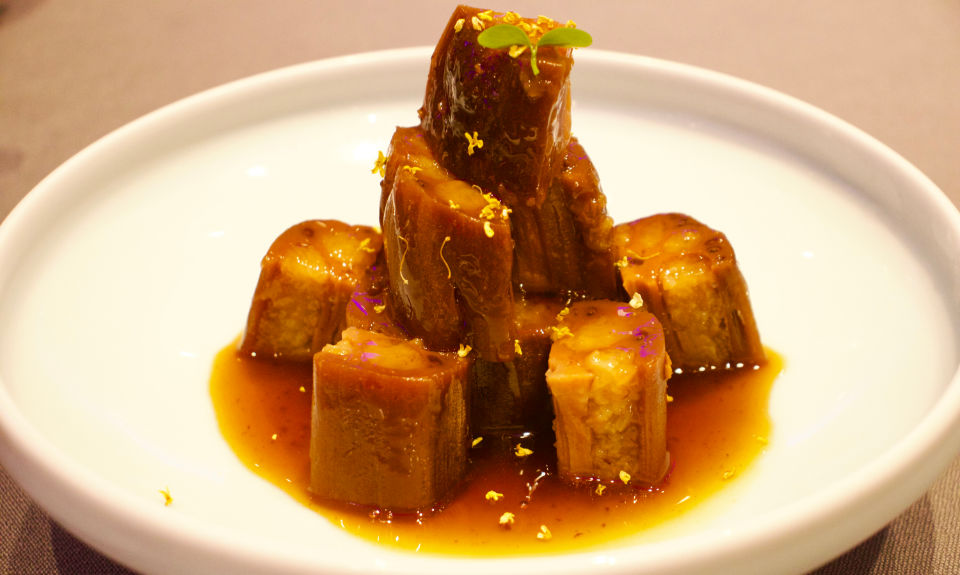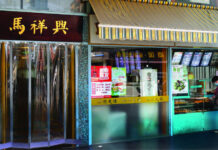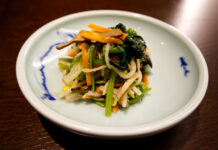The night of 1912 is not quiet. The noisy bars, the colourful Ferris wheel, the flashing neon and fashionable people make for a splendid city scene. Yet Shi Wang Fu stands as still as the nearby lake’s waters, displaying an elegant Chinese air.
A clean and tidy marble facade sports an ivory palette of colour under a soft, white light. The golden carved door, the smiling waiters who receive you, the name of the restaurant in beautiful calligraphy, the red carpet that stretches deep into the interior; all display the understated luxury and grandeur of an upscale restaurant. The decoration continues in this style, with a bright and simple lobby that is pleasant to both mind and body.
The menu at Shi Wang Fu is based on Huaiyang cuisine, with an overall style of cooking that is more refined, making it suitable for both family and friends to gather, but also as an excellent choice for banquets.
Millennium brine squab is my favourite. For it is said that one pigeon is better than nine chickens. With many years of history, it is considered a sibling of Nanjing brine duck. According to the menu, this particular variant was developed by Shi Wang Fu in the year 2000, hence the name.

It uses a squab pigeon which is just 18 days old and with a net weight of 300 grams. On the side that is cut open, the lines of its muscles are shallow and fine. With a squab of good quality, the smell of raw flesh is deftly handled, and its saltiness and aroma are a tad light, which can be said to be just right. A very thin layer of oil floats on the surface, making it mouth-watering.
Once therein, its taste is a little salty, then fresh and delicate, leaving a fragrance on both lips and teeth.
Then there is the sweet root with cinnamon, a traditional dessert with intense colour and flavour. With delicate, small osmanthus flowers dotting it, the sugar-colored lotus root fills the room with fragrance, becoming most tempting. In the mouth, that osmanthus stimulates the tongue with a refreshing sweetness. Then comes the sticky texture, thick but not greasy; the two complement each other and satisfy every appetite.
It is worth mentioning that the osmanthus sweet root, along with osmanthus sweet taro seedlings, plum blossom cake and red bean stuffed dumplings, are known as the four-most-loved street snacks in Nanjing.

Then, before the cold dishes were finished, our heavyweight guest, Lion’s Head, made an appearance.
There are two versions of Shi Wang Fu’s Lion’s Head, the one I ordered in clear soup, which is relatively light, and the other with crabmeat, which is far richer and more expensive. A large meat round, white and warm, like mutton fat jade, is served in a delicious soup, with refreshing vegetables that relieve the greasiness. The head itself is very tender, almost like doufu, but then comes the aroma of fatty meat and the freshness of the soup. At this point, accompanied by a mouthful of steaming rice, it is a rare enjoyment.
Each lion’s head weighs half a “jin” (斤; 250 grams), and its cooking process is very elaborate. The meat is selected from prime pork ribs, and each strand cut by hand to maintain the tenderness and taste. Then it is slowly stewed over a gentle heat.
The origin of “lion’s head” as a name goes back to the Sui Dynasty. That was when the famous chef, Wei Juyuan, by invitation of Wei Zhi, Duke of the Tang Dynasty, made the four famous dishes of Yangzhou, winning the guests’ praise. In particular, the “sunflower chopped meat”, made from the huge meatballs, was most wonderful. When cooked to maturity, most of the fatty meat on the surface of the meatballs had melted away, giving the remaining lean meat a rough and bumpy appearance at first glance. Just like a lion’s head.

Wei happily raised his cup and drank it down in one, saying, “To commemorate today’s event, ‘sunflower-chopped meat’ might as well be changed to ‘lion’s head’”.
That name, Yangzhou Lion’s Head, has been passed down to the present day.
After leaving with a full stomach, I took a ride on the Ferris wheel in 1912 to enjoy the night view of Baijia Lake under a dimming sky. People relaxed by the sparkling lake. Adults with children, couples snuggled up to each other, all in all a most loving scene. Shi Wang Fu, overlooking from its elevated position in the midst of all the lights and greenery, sits like a small bright moon, set in the centre of the huge coloured gem that is 1912, emitting a gentle and quiet light as a beacon of Nanjing cuisine.















